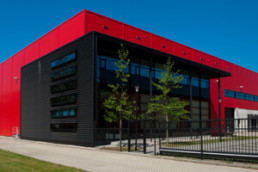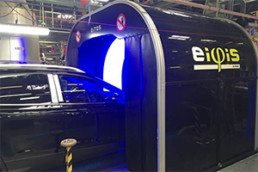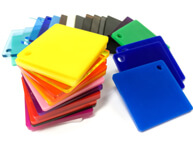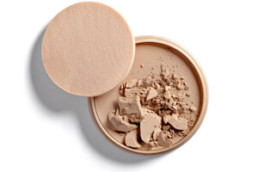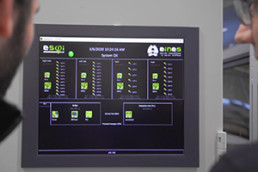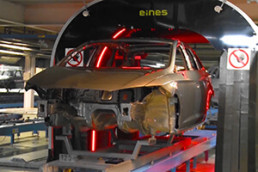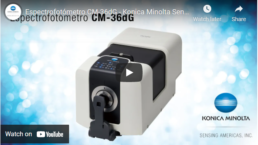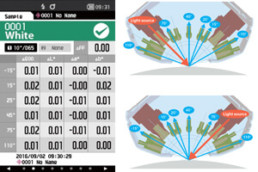Factors to Consider When Evaluating a Building's Quality
There are several factors to consider when evaluating the quality of a building. Color is one of the first things that a person sees, and mismatched colors can be quickly apparent. If two sides in the building do not match due to different paint batches, or the noticeable repainting of a side or part of the siding to cover a repair, quality becomes quickly suspect. With vinyl siding, even slightly out of specification colors can make a house look like a checkerboard; the seams become obvious everyone wants seamless color in the siding. Roof tiles should match even after replacement due to age or storm damage. The window frames and sashes need to match even if they come from different manufacturing lots. The same applies to glass office towners in the city, the windows must look the same if viewed close up or from a distance, and a slight color difference in a glass panel will be noticeable and degrade the appearance of the building.
The CM-5 spectrophotometer is the ideal instrument for measuring and analyzing color in building materials. The CM-5 can perform a wide range of measurements whether the material is solid, powder, paste, or liquid.
If you are measuring a solid material, place the sample on top of CM-5's measurement aperture, much like putting a sample on a scale to get its weight. If a sample is a grout or stucco in a paste form, use a petri dish. Fill the petri dish with the sample, place it on the measurement aperture, and take a measurement.
In addition, the CM-5 has transmission measurement capability for the measurement of liquid and transparent materials such as glass and films. Place a sample in the transmittance measurement chamber of the instrument to take measurements. Measurements are quick, with just a few seconds to output and save spectral data. For glass and other transparent material analysis, besides color data, the CM-5 provides valuable data such as spectral transparency, absorbance, and haze.
With broad measurement capability for various materials, The CM-5 is the must-have instrument for the color quality of building materials in your lab.
Why Use Machine Learning Vision for Part-In-Motion Quality Inspections
Quality and throughput have always guided manufacturers to invest in new processes and technology. The influx of advanced Industry 4.0 technology offers manufacturing leaders many choices—like 3D printing, artificial intelligence, and machine learning.
Machine Learning (ML) is gaining popularity across various industries and applications, such as automotive, aerospace, medical, and electronics. It exceeds operational needs and provides tangible benefits such as effective instantaneous inspections and traceability.
The design of Eines Vision System's digital software technology is explicitly for part-in-motion quality inspections. Through its advanced machine learning algorithms, Eines can intelligently perform part confirmations, calculations, and simulations of measurements. At the same time, the inspected surface remains moving, like parts that reside on a conveyor line, lifts, automated guided vehicles, and assembly belts.
There are three main types of error-proofing environments to apply advanced machine learning vision quality inspections common to automotive production: stop station scanning, place part-in-fixture scanning, and part-in-motion dynamic scanning measurements. Of the three, part-in-motion dynamic inspection delivers the most benefits, expanding past typical basic visual inspection to dynamic tracking of parts for critical measurements.
In final assembly vehicle manufacturing, there are three preeminent applications using best-practice vision technology for dynamic part-in-motion measurements: gap n flush measurements, surface coatings integrity inspections, and part present validation verifications.
Gap N Flush Measurements (sometimes referred to as fit n finish): gap n flush is the dimensional relationship between mating parts such as doors, trunks, fenders, liftgate, and hoods. Precise measurement is critical for line fitters performing operational alignment to reduce wind noise and improve vehicle aesthetics.
Surface/Coatings Inspections: automotive manufacturers have only seconds to inspect surface conditions for splits, cracks, scratches, dents, dirt, orange peel, fishers, and blisters. Once in the showroom, customers have hours to inspect surface integrity. Surface imperfections can cause future warranty issues; therefore, detection data metrics needs to be instant to perform sanding and polishing before final vehicle acceptance.
Part Present Verification: Commonly known as a Poka-yoke process designed to avoid manufacturing mistakes. Essential to best practices, advanced vision technology can detect missing clips, nuts, emblems, badges, match vehicle style, mirrors, bumper features, or color validation with customer orders.
Providing the line technicians' actionable data analytics generated from quality inspection metrics. The data dashboard consists of defects displayed within multiple digital visual feedback interfaces such as tablet-based, wearable, and fixed monitor-based displays.
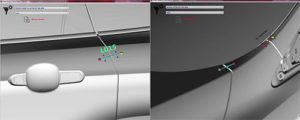
Some factories attempt to test and simulate process designs with digital twin models. The digital twin illustrates dynamic simulations of detections, what an operation would look like and how a worker should perform it. It allows for a complete look at processes and traceability to identify specific problems within the operation. It is also deployable on an enterprise level, easily interfacing with common cloud platforms to create custom dashboards and analytics.
Successful manufacturing processes can make every second and every penny count in their operations. Tunnel-style inspection systems harness the production line's speed and rapid data transfer to provide a minimal maintenance high throughput system. This system reduces the risk of downtime while operating very self-sufficient when integrated into existing plant power and communication networks.
For many years, part-in-motion dimensional control inspections have challenged the quality metrics for high production automotive operations. Eines' advanced vision software configured to the customer's specifications deployed through tunnel-style systems solves the problem of accurate error proofing for part-in-motion inspections.
To find out more about dynamic digital inspection systems, please contact our team or request an application assessment.
The Steps to Consistent Color in Plastics
Expert color duplication at every stage of production is vital to quality control, cost, client satisfaction and retention. As with color measurement of all materials. accurate color control of plastics depends on precision and consistency. This is the process for achieving optimum color control...
Achieving a Standard Color in Cosmetic Foundations
Foundation has been a part of our lives for thousands of years. Once known as “face painting”, foundation has transformed through the ages dating as far back to ancient Greece and Rome, and maybe even further. Through many variations, including some with toxic ingredients such as white lead and mercury, “foundation” wasn’t known as such, until “The Father of Make-Up”, Max Factor, named it and included it in his product portfolio in 1920.
Sadly, for years, there were only limited shades of foundations. However and happily, in today’s world, there are many different shades, made with different ingredients to appeal not only to a consumer’s eye for color but potentially to their social consciousness as well. With the increase in the pallet of available foundation hue and ingredients, it is more important than ever to sustain proper color control. A properly maintained spectrophotometer allows manufacturers to ensure consistent colors from concept/design to R&D, to production, and finally to the consumer. Products such as the Konica Minolta Sensing's CM-5 or CM-700d would be essential in color consistency in foundation.
By developing a standard color for each shade of foundation, manufacturers can subjectively (visually) assure acceptability with the use of a light booth, which offers standardized viewing conditions, and can replicate how the foundation will look in the store as well as in the home, office, and outdoors. In combination with that technique, the use of a spectrophotometer (like the CM-5 and CM-700d mentioned above) will allow for objective measurements that allow quantitative data for any samples for color quality control and communication. By using this measured information, be it spectral data or tristimulus data (such as CIEL*a*b*), any non-acceptable deviation from the standard come to be quickly and easily communicated to the appropriate personnel and the proper corrective action taken. Catching incorrectly colored products early in the production cycle saves manufacturers time and money, and drastically reduces rework and waste.
This process is especially beneficial when using synthetic versus organic ingredients (or vice versa), all while trying to attain the same color. The base colorants in the foundation will likely react differently with diverse ingredients, giving varying results. The use of a spectrophotometer will give the applicable personnel quantitative data that is likely to be undetected by the human eye due to the variation of ingredients. This will allow for proper adjustments to be made with the base colorants to achieve the desired, standard color of the foundation.
Using the objective data a spectrophotometer provides, staff can effectively and precisely communicate the desired color from various locations, with R&D potentially in one country, and production in another. With a proper color quality control process in place, foundation and make-up companies can assure customers that their products will look as good as promised, and will stay the same color from their first purchase, onward.
Artificial Intelligence A Paint Shop Automation Best Practice
Today operations, quality, and manufacturing managers have a choice when facing the dilemma in error-proofing efforts. Repeat methodologies from the past or go forward using Artificial Intelligence (AI).
Managers confront the question - do we adopt new technologies or continue with the status quo? Today's automakers face one issue: advanced digital automation must be flexible, robust, affordable, and efficient when installed on moving lines. That generally includes a rollout of lean principles integrated with digital automation. Without Artificial Intelligence (AI) integrated into the factory software, measuring defects on a moving line will pose serious problems in repeatability and accuracy.
According to the FMEA (Modal Analysis of Failures and Effects) inspection process guidelines, the "human visual inspection" is effective or reliable in only 80% of cases based on the observation of multiple factors such as different points of sight or operators, reduced cycle time, visual fatigue and defects not detected by the human eye, among others things.
Human intelligence is summarily the mental quality that consists of learning from experience, adapting to new situations, understanding and handling abstract concepts, and using knowledge to manipulate one's environment.
Artificial intelligence (AI) uses data and algorithms to replicate human decision/thinking ability. AI offers scalability while taking a good quality process and making it "best practice." This while providing manufacturing intelligence and innovation to achieve today's tightened customer quality requirements. (I.e., IATF-16949)
Latest trends in manufacturing and production technologies, including augmented reality, artificial intelligence, and industrial robotics, offer ways to increase productivity, improve quality and reduce cost by automating complex and monotonous tasks. Likewise, surface simulation technologies can leverage real-time data and mirror the physical world in virtual models, including machines, products, and humans.
Eines Vehicle Scanning Simulation (EVSS) optimizes the number of cameras used and reduces implementation time as configuration actions can occur offline. EVSS also allows for pre-planning multiple configurations for all current and future car bodies. Eines has developed a tool to simulate the whole inspection process utilizing the vehicle 3D model outer skin and support all required camera 3D data calibration to provide accurate coordinates of subsequent process steps and precise vectors for auto-repair processes.
AI is a top to bottom quality control concept streamlining your relationships with suppliers and customers. Strengthening AI algorithms to mimic human intelligence increases the production process's speed, flexibility, and efficiency, thus leading to a broader range of products.
The EINES Esφi Moving Line Surface Quality Production Scanner. The original moving line integrated AI system can scan vehicles on a moving line with short cycle times, no interruption of production tact times, and low maintenance, resulting in higher productivity and efficiency.
Enabling Paint Shop Industry 4.0 with Artificial Intelligence
Within the Paint Shop in the current Industry 4.0 age, innovation is a non-negotiable proposition. Innovate or liquidate, after the first wave of advanced automation, which disrupted many manufacturing processes with such precision that lagging adopters of this new technology ended up on the sidelines. Those lagging often saw auction signs placed in front of their place of business. No organization is immune from the increasing demands to build products better, faster, and with higher degrees of customization.
For instance, customer choices in vehicle paint coatings have escalated to some models offering over 60 color variations all built at the same plant, on the same line, with the same equipment, and in the same production environment.
Paint Shops at automakers must make a substantial leap with the deployment of new equipment, software, and technologies. Advanced high-resolution vision systems mated with Artificial Intelligence (AI) on a moving line have made significant contributions to paint defect detection before the final product reaches the customer's eyes.
AI can provide proven benefits to quality while maintaining throughput goals set by the production demands. AI in the paint shop has demonstrated a noticeable cost saving warranting an immediate consideration and adoption for the following reasons.
- AI technology is becoming mainstream in the workplace
- AI can unlock new operational capabilities within your organization by simplifying assembly, inspection, and maintenance processes
- What types of digital vision solutions mated with AI exist in the market today
- What factors you should consider when evaluating digital vision systems with AI tools
Software AI is a top to bottom quality control concept streamlining your relationships with suppliers and customers. Strengthening AI algorithms to mimic human intelligence increases the production process's speed, flexibility, and efficiency, thus leading to a broader range of products.
The EINES Esφi Moving Line Surface Quality Production Scanner – is an innovative integrated AI system able to scan vehicles on a moving line with short cycle times, no interruption of production tact times, and low maintenance, resulting in higher productivity and efficiency.
Instrument validation in the pharmaceutical industry
The pharmaceutical industry is one of the strictest industries to perform GMP (good manufacturing practice). For pharmaceutical companies to maintain a high GMP quality, proper qualification and validation protocols must be in place for the highly regulated pharmaceutical industry. Validation for an instrument is essential for maintaining the high-quality production of pharmaceutical products, and ensuring proper color measurement is necessary. Validation of an instrument usually consists of Installation Qualification (IQ), Operational Qualification (OQ), and Performance Qualification (PQ).
How To Use a CM-36dG
In this tutorial video, you will learn how to use the CM-36dG Spectrophotometer and gain a basic knowledge of how to use the instrument right out of the box.
The Spectrophotometer CM-36dG is a high-precision and high-reliability bench-top instrument capable of measuring color either in reflectance or transmittance, ideally suited to a wide range of applications such as Plastics, Paints, Ceramics, Chemicals, etc.
The Challenges of Controlling Automotive Color and Appearance
Qualifying car color is a challenging process. Manufacturers face challenges when measuring small or curved surfaced parts. The curvature in a shark fin antenna, door mirrors, or handles often makes it difficult to position a measuring instrument. Small spaces or gaps between the instrument and the sample’s surface result in unreliable color data. Overcoming this problem requires an instrument that can measure a small area.
The dynamic appearance of today's leading auto brands is often created by using metallic or pearlescent finishes. These paints also create their own set of measurement challenges. Both paints contain aluminum or mica flakes that reflect light in different directions. Different reflection directions lead to variations in color and brightness levels depending on illumination and viewing settings. What this all means is the vehicle’s appearance depends on how you are observing it. A paint-coated surface that looks different, at different viewing angles, can only be measured and quality-controlled with a multi-angled instrument.
The commonalities between the two challenges? Their solutions. Both need multiple angles of measurement with a high measurement repeatability. Both need an instrument like the Spectrophotometer CM-M6. Equipped with a Ø12 mm aperture for measurement of 6mm, the CM-M6 features 6 aspecular viewing angles (-15°, 15°, 25°, 45°, 75°, 110°) that measure the various metallic and pearlescent paints colors as well as brightness levels produced by reflected light.
To eliminate the small spaces and uncovered gaps that result in unreliable color data, the CM-M6 has a built-in, patented double path illumination system that uses 2 symmetrical optical systems. This system compensates for any slight inclination to the instrument position during measurement, offering stable measurement results on a non-flat surface (i.e. radius> 300).
Same car different color
If you grew up in the '70s, the Pontiac Trans Am was probably on your shortlist of dream cars, and you had a poster of one hanging in your room. Most are familiar with the "Bandit" Black and Gold Special Edition Trans Am. However, did you know that there was a Gold Edition Trans Am in the late 70s?
In the '70s, Pontiac auto plants in Norwood, Ohio, and Van Nuys, California, built the Gold Edition Trans Am. Trans Am aficionados will point out that they can tell in which factory the car was painted. They would say that the cars from the Van Nuys factory have more of a greenish tint as opposed to the deeper gold paint found on the Ohio models because EPA regulations were stricter at the California Pontiac plant. While this is an amusing antidote some forty years later, this would be unacceptable in today's modern automobile manufacturing environment.
Today automotive manufacturers employ strict standards to ensure that every vehicle that comes off the assembly line has the perfect color consistently, regardless of the location of manufacture. In addition, many parts come from a multitude of external vendors, and they must provide consistent part colors to all locations. As a result, it becomes a challenge to match the color and appearance of all of the parts. Therefore, manufacturers need to provide exact specifications to suppliers.
Manufacturers often have specialized coating processes, and their paint will have a unique color formulation process. While visual inspection is necessary, it may not meet quality control standards and demands for exact color matching on all parts. Engineers have found it beneficial to use spectrophotometers such as the multi-angle CM-M6 for objective evaluations and adopting a numerical color inspection system to ensure consistency.
To improve quality and appearance, you would use an instrument like the Rhopoint TAMS, an innovative measuring system for characterizing the visual quality of functional and decorative surfaces. TAMS uses four parameters to produce a comprehensive description of the visual sensation: Contrast, image sharpness, waviness, and dominant structure size (dimension).

